Electric Potential Multiple Choice Question And Answers
Question 1. A positively charged particle is released from rest in a uniform electric field. The electric potential energy of the charge
- Remains constant because the electric field is uniform
- Increases because the charge moves along the electric field
- Decreases because the charge moves along the electric field
- Decreases because the charge moves opposite to the electric field
Answer: 3. Decreases because the charge moves along the electric field
The positive charge will move along the electric field, i.e., it will move from higher to lower potential. Therefore, the electric potential energy will decrease.
Question 2. The electrostatic potential on the surface of a charged conducting sphere is 100 V. Two statements are made in this regard
S1: At any point inside the sphere, electric intensity is zero.
S2: At any point inside the sphere, the electrostatic potential is 100 V.
Which of the following is a correct statement?
- S1 is true but S2 is false
- Both Sj and S2 are false
- S1 is true, S2 is also true and S1 is the cause of S2
- S1 is true, S2 is also true but the statements are independent
Read and Learn More Class 12 Physics Multiple Choice Questions
Answer: 3. S1 is true, S2 is also true and S1 is the cause of S2
The field E inside a conductor is zero.
⇒ \(E=-\frac{d V}{d r}\)
or, -Edr = dV = 0
∴ V is constant
Question 3. Equipotentials at a great distance from a collection of charges whose total sum is not zero are approximately
- Sphere
- Planes
- Paraboloidsÿ
- Ellipsoids
Answer: 1. Sphere
Question 4. Equipotential surfaces
- Are closer in regions of large electric fields compared to regions of lower electric fields
- Will be more crowded near the sharp edges of a conductor
- Will be more crowded near regions of large charge densities
- Will always be equally spaced
Answer:
1. Are closer in regions of large electric fields compared to regions of lower electric fields
2. Will be more crowded near sharp edges of a conductor
3. Will be more crowded near regions of large charge densities
Question 5. The work done to move a charge along an equipotential from A to B
- Cannot be defined as \(-\int_A^B \vec{E} \cdot d \vec{l}\)
- Must be defined as \(-\int_A^B \vec{E} \cdot d \vec{l}\)
- Is zero
- Can have a non-zero value
Answer:
2. Must be defined as \(-\int_A^B \vec{E} \cdot d \vec{l}\)
3. Is zero
⇒ \(W=-\int_A^B \vec{E} \cdot d \vec{l}=-\int_A^B E d l \cos \theta\)
For the equipotential surface, θ = 90°.
So, W = 0
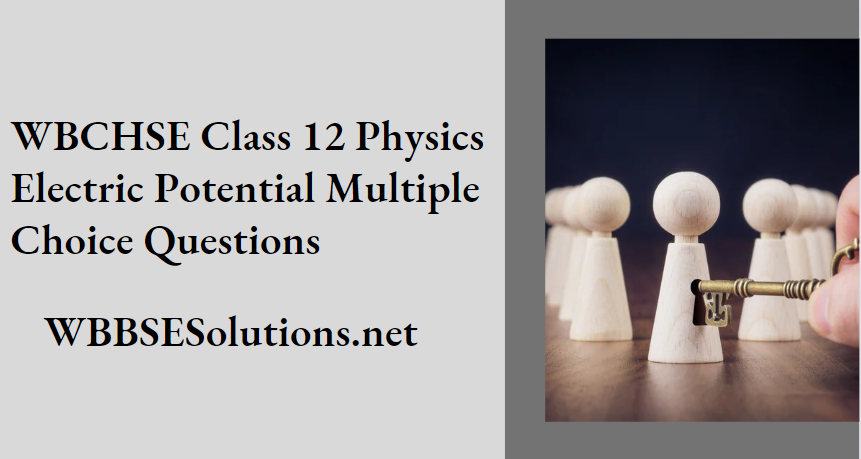
Question 6. In a region of constant potential
- The electric field is uniform
- The electric field is zero
- There can be no charge inside the region
- The electric field shall necessarily change if a charge is placed outside the region
Answer:
2. The electric field field is zero
3. There can be no charge inside the region
⇒ \(E=-\frac{d V}{d r}\)
If V is constant, then E = 0
Again, \(\oint_S \vec{E} \cdot d \vec{S}=\frac{q}{\epsilon_0}\)
Since E= 0.
So, q = 0
Question 7. Which of the following quantities do not depend on the choice of zero potential or zero potential energy?
- Potential at a point
- The potential difference between the two points
- The potential energy of a two-charge system
- Change in potential energy of a two-charge system
Answer:
2. Potential difference between two points
4. Change in potential energy of a two-charge system
Question 8. p is a point on an equipotential surface S. The field at P is E
- E is perpendicular to S in all cases
- E is perpendicular to S only if S is a plane surface
- E cannot have a component along a tangent to S
- E may have a non-zero component along a tangent to S if S is a curved surface
Answer:
1. E is perpendicular to S in all cases
3. E cannot have a component along a tangent to S
Question 9. When a proton is accelerated from rest through a potential difference of 1000 V, its kinetic energy becomes
- 1.6 x 10-16 J
- 1.6 x 10-13 eV
- 1000J
- 1000 eV
Answer:
1. 1.6 x 10-16 J
4. 1000 eV
Question 10. In a uniform electric field, equipotential surfaces must
- Be Plane Surfaces
- Be Normal To The Direction Of The Field
- Be Spaced Such That The Surfaces Having Equal Differences In Potential Are Separated By Equal Distances
- Have Decreasing Potentials In The Direction Of The Field
Answer:
1. Be Plane Surfaces
2. Be Normal To The Direction Of The Field
3. Be Spaced Such That The Surfaces Having Equal Differences In Potential Are Separated By Equal Distances
4. Have Decreasing Potentials In The Direction Of The Field
Question 11. An ellipsoidal cavity is cut within a perfect conductor. A positive charge Q is placed at the centre of the cavity. If points A and B are on the cavity surface then which among the following choices are correct?
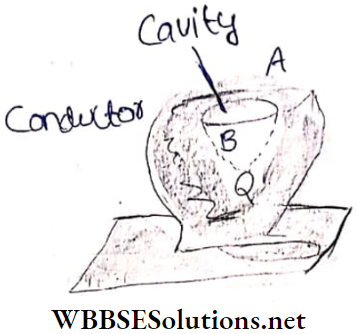
- Electric field near A = Electric field near B
- Potential at A = potential at B
- The total electric flux through the entire surface of the cavity \(\frac{Q}{\epsilon_0}\)
- Charge density at A = charge density at B
Answer:
2. Potential at A = potential at B
3. Total electric flux through the entire surface of the cavity \(\frac{Q}{\epsilon_0}\)
Question 12. A conductor A is given a charge of around +Q and then placed inside a deep metal can B, without touching it.
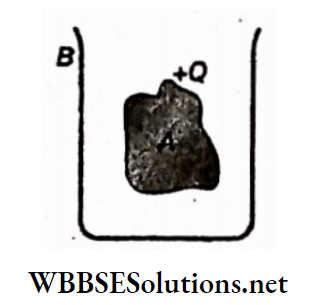
- The potential of A does not change when it is dipped inside B.
- If B is earthed, +Q amount of charge flows from it to the earth
- If B is earthed, the potential of A is reduced
- Either 2 or 3 is, true or both are true only if the outer surface of B is connected to the media. i surface
Answer:
1. The potential of A does not change when it is dipped inside B.
2. If B is earthed, +Q amount of charge flows from it to the earth
3. If B is earthed, the potential of A is reduced
Question 13. For a spherical symmetrical charge distribution, variation of electric potential with distance from the centre Is given in the diagram. Given that \(V = \frac{1}{4 \pi \epsilon_0} \frac{q}{R_0} ; \text { for } r ≤ R_0 \text { and } V=\frac{1}{4 \pi \epsilon_0} \frac{q}{r}\) r ≥ R0. Choose the correct options.
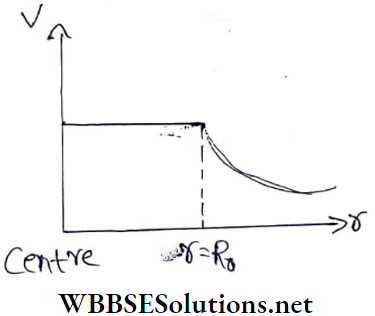
- The total charge within 2R0 is q
- Total electrostatic energy for r≤R0 is zero
- At r = R0 electric field is discontinuous
- There will be no charge anywhere except at r = R0
Answer:
1. Total charge within 2R0 is q
2. Total electrostatic energy for r≤R0 is zero
3. At r = R0 electric field is discontinuous
4. There will be no charge anywhere except at r = R0
Question 14. An elliptical cavity is carved within a perfect conductor. A positive charge q is placed at the centre of the cavity. Points A and B are on the cavity surface. Then,
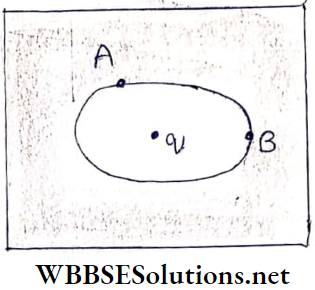
- The electric field near A in the cavity = electric field near B In the cavity
- Charge density at A = charge density at B
- Potential at A = potential at B
- The total electric flux through the surface of the cavity is \(\frac{q}{\epsilon_0}\)
Answer:
3. Potential at A = potential at B
4. Total electric flux through the surface of the cavity is \(\frac{q}{\epsilon_0}\)
Question 15. Four charges, all of the same magnitude, are placed at the four corners of a square. At the centre of the square, the potential is V and the field is E. Which of the following is possible?
- V = 0, E = 0
- V= 0, E ≠ O
- V ≠ 0, F = 0
- V ≠ 0, E ≠ 0
Answer:
1. V = 0, E = 0
2. V= 0, E ≠ O
3. V ≠ 0, F = 0
4. V ≠ 0, E ≠ 0
Question 16. Which of the following statement (s) is/are correct?
- If the electric Hold duo lo a point charge varies aa r-2.5 Instead of r-2, then Gatins’ law will still ho valid
- Gatina’s law can ho linked to calculating holding around an electric dipole
- If the electric field at some point between two points charges In zero, then the algo of two charged la the name
- The work done by the external force In moving a unit positive charge from point A at potential VA to point B at potential VB is (VB– VA)
Answer:
3. If the electric field at some point between two points charges In zero, then the algo of two charged la the name
4. The work done by the external force In moving a unit positive charge from point A at potential VA to point B at potential VB is (VB – VA)
Question 17. Six-point charges are kept at the vertices of a regular hexagon of side L, and center O. Given that \(K=\frac{1}{4 \pi \epsilon_0} \frac{q}{L^2}\). Which of the following statements is correct?
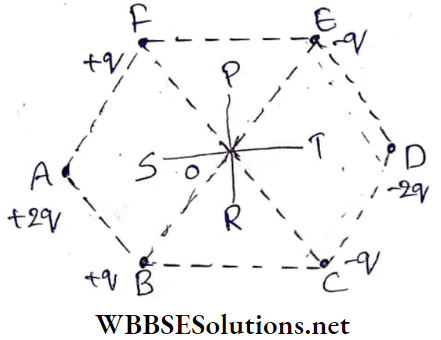
- The electric field at O is 6K along OD
- Potential at O Is zero
- Potential at all points on the line PR Is the same
- Potential at all points on the Lino ST Is the same
Answer:
1. Electric field at O is 6K along OD
2. Potential at O Is zero
3. Potential at all points on the line PR Is the same
Question 18. Some of the field lines correspond to an electric field. If E = electric field and V = potential, then
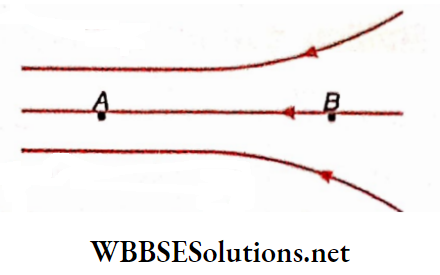
- EA > EB
- BA < EB
- VA > VB
- VA < VB
Answer:
1. EA > EB
4. VA < VB
Question 19. The number of statvolt corresponding to 1 volt is
- \(\frac{1}{100}\)
- 109
- \(\frac{1}{300}\)
- 300
Answer: 3. \(\frac{1}{300}\)
Question 20. 1V m-1 =?
- 1N.C-1
- 3 x 1010 N.C-1
- 107N.C-1
- 1010 N.C-1
Answer: 1. 1N.C-1
Question 21. When a body is connected to the earth, electrons flow from the earth to the body. The body is
- Negatively charged
- Insulator
- Uncharged
- Positively charged
Answer: 4. Positively charged
Question 22. In a uniform electric field of intensity E, a small charge q is carried once along the elliptical path ABCD. The amount of work in the paths AB, BC, CD and DA are respectively W1, W2, W3, W4, then
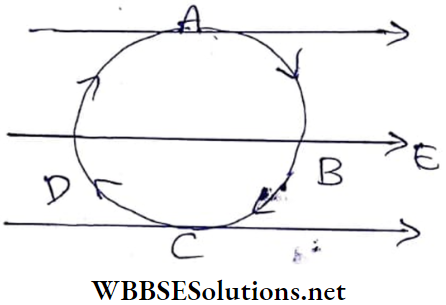
- W1 = W2 = W3 = W4 ≠ 0
- W1 = W2 = W3 = W2 = 0
- W1 + W2 + W3 + 4 = 0
- W1 = W2+ W3-W4 = 0
Answer: 3. W1 + W2 + W3 + W4 = 0
Question 23. Four point changes each + q is placed on the circumference of a circle of diameter 2d in such a way that they form a square. The potential at the centre of the circle (in CGS) is
- 0
- \(\frac{4q}{d}\)
- \(\frac{4d}{q}\)
- \(\frac{q}{4d}\)
Answer: 2. \(\frac{4q}{d}\)
Question 24. Work done in taking a point charge from P to A is WA, from P to B is WB and from P to C is WC. Which of the following options is correct?
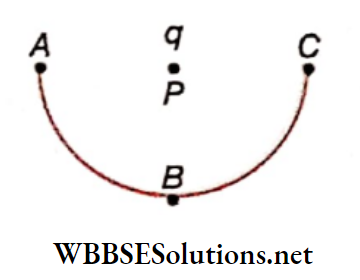
- WA < WB < WC
- WA>WB>WC
- WA = WB = WC
- None Of These
Answer: 3. WA = WB = WC
Question 25. The radius of a soap bubble whose potential is 16 V is doubled. The new potential of the bubble is
- 2 V
- 4 V
- 8 V
- 16 V
Answer: 3. 8 V
Question 26. Four electric charges +q, +q,- q, and- q are placed at the comers of a square of side 2L. The electric potential at point A midway between the two charges + q and +q is
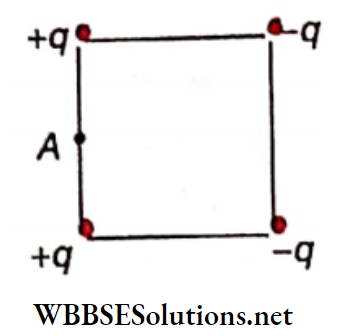
- \(\frac{1}{4 \pi \epsilon_0} \frac{2 q}{L}(1+\sqrt{5})\)
- \(\frac{1}{4 \pi \epsilon_0} \frac{2 q}{L}\left(1+\frac{1}{\sqrt{5}}\right)\)
- \(\frac{1}{4 \pi \epsilon_0} \frac{2 q}{L}\left(1-\frac{1}{\sqrt{5}}\right)\)
- Zero
Answer: 3. \(\frac{1}{4 \pi \epsilon_0} \frac{2 q}{L}\left(1-\frac{1}{\sqrt{5}}\right)\)
Question 27. A charge Q is placed at the center of the circle ABCDE. Work done to bring another charge q from A to B, C, D, and E is
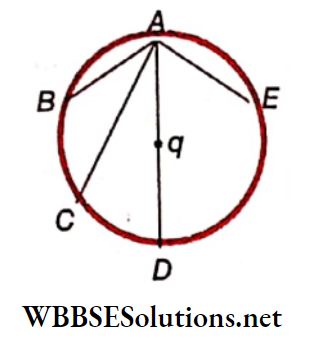
- Minimum along the path AB
- Maximum along the path AD
- Zero along each of the paths AB, AC, AD, AE
- Positive but equal along all the paths
Answer: 3. Zero along each of the paths AB, AC, AD, AE
Question 28. Work done to carry a charge q once along the circular path of radius r with charge q’ at its centre, will be
- 0
- \(\frac{q q^{\prime}}{4 \pi \epsilon_0}\left(\frac{1}{\pi r}\right)\)
- \(\frac{q q^{\prime}}{4 \pi \epsilon_0}\left(\frac{1}{2 \pi r}\right)\)
- \(\frac{q q^{\prime}}{4 \pi \epsilon_0 r}\)
Answer: 1. \(\frac{q q^{\prime}}{4 \pi \epsilon_0}\left(\frac{1}{\pi r}\right)\)
Question 29. There is a uniform electric field of intensity E. How many labelled points do have the same potential as the fully shaded point? ‘
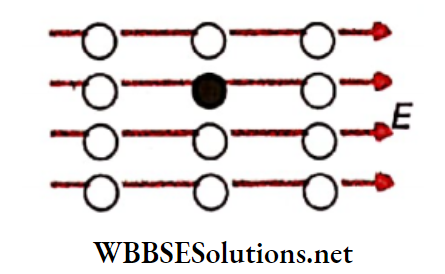
- 2
- 3
- 8
- 11
Answer: 2. 3
Question 30. If a charge is displaced against the Coulomb force in an electric field
- Work is flooded by the electrical force
- Work is done by an electric agency
- The energy of the electric, field decreases
- The energy of the system decreases
Answer: 2. Work is done by an electric agency
Question 31. Three point charges each equal to q are placed on the vertices of an equilateral triangle of side 1. The potential energy of the system is
- \(\frac{1}{4 \pi \epsilon_0} \cdot \frac{q^2}{l}\)
- \(\frac{1}{4 \pi \epsilon_0} \cdot \frac{2 q^2}{l}\)
- \(\frac{1}{4 \pi \epsilon_0} \cdot \frac{3 q^2}{l}\)
- \(\frac{1}{4 \pi \epsilon_0} \cdot \frac{4 q^2}{l}\)
Answer: 3. \(\frac{1}{4 \pi \epsilon_0} \cdot \frac{3 q^2}{l}\)
Question 32. There is a charge of 10μC at the centre of a circle of radius 10 m. The work done in moving a unit positive charge once around the circle is
- 0
- 100 J
- 10 J
- 150 J
Answer: 1. 0
Question 33. An electron of mass m and charge e is accelerated from rest through a potential difference V in a vacuum. Its final speed will be
- \(\sqrt{\frac{2 e V}{m}}\)
- \(\sqrt{\frac{2 V}{m}}\)
- \(\frac{e V}{m}\)
- \(\frac{e V}{2m}\)
Answer: 1. \(\sqrt{\frac{2 e V}{m}}\)
Question 34. The radius of a charged hollow metal sphere is 5 cm and its surface potential is 10 V. Potential at its centre is
- 0
- 10V
- Equal to the potential at k distance 5 cm away from its surface
- Equal to the potential at a distance 25 cm away from its surface
Answer: 2. 10V
Question 35. The variation of electric potential with distance from a fixed point. What is the value of electric field intensity at x = 2 m?
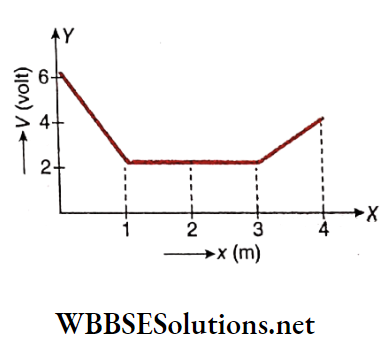
- 0
- 3 V.m-1
- 6 V.m-1
- 2 V.m-1
Answer: 2. 6 V.m-1
Question 36. If the equation of electric field is \(\vec{E}=(y \hat{i}+x \hat{j})\), then the equation of electric potential is represented by
- V = -(x + y) + constant
- V = constant
- V = -(x² + y²) + constant
- V = – xy + constant
Answer: 4. V = – xy + constant
Question 37. A charge of 3C experiences a force of 3000 N in a uniform electric field. The potential difference between two points situated 1 cm apart along the electric lines of force will be
- 300 V
- 100 V
- 30 V
- 10 V
Answer: 4. 10V
Question 38. The electric potential V at any point (x, y, z) all in metres in space is given by V = 4 x 2V. The electric field at the point (1, 0, 2) in V.m-1 is
- 8 along the negative X-axis
- 8 along the positive X-axis
- 16 along the negative X-axis
- 16 along the positive X-axis
Answer: 1. 8 along the negative X-axis
Question 39. Two points A and B are 2 cm apart and a uniform electric field 1? acts along the straight line AB directed from A to B with E = 200 N.C-1. A particle of charge +10-6C is taken from A to B along AB.
1. The force on the charge is
- 2 x 10-4 N
- 3N
- 2N
- 2x 10-2 N
Answer: 1. 2 x 10-4 N
2. The potential difference between A and B is
- 4 x 10-6 V
- 1 V
- 4V
- 2 V
Answer: 3. 4V
3. The work done on the charge by \(\vec{E}\) is
- 4J
- 1 x 10-6 J
- 2 x 10-6 J
- 4 x 10-6 J
Answer: 4. 4 x 10-6 J
Question 40. Two point charges q1 = 10 x 10-6C and q2 = -2 X 10-8C are separated by a distance of 6 cm in air.
1. The distance from q1 of the point of zero electric potential is
- 5 cm
- 2.5 cm
- 8 cm
- 10 cm
Answer: 1. 5 cm
2. The electrostatic potential energy of the system is
- 15 X 10-3J
- 24 x 10-4 J
- 18 X 10-3 J
- -18 X 10-4 J
Answer: 4. -18 X 10-4 J
Question 41. A positively charged oil drop is in equilibrium in the electric field existing in the space between two horizontal plates separated by a distance of 1 cm. The charge of the oil drop is 3.2 x 10-19C and its mass is 10-17 g.
1. The potential difference between the plates is
- 1020 V
- 1531 V
- 3062 V
- 2454 V
Answer: 3. 3062 V
2. The instantaneous acceleration of the oil drop, when the polarity of the two plates is reversed, is
- 24.54 m.s-2
- 19.60 m s-2
- 29.70 m s-2
- 34.52 m.s-2
Answer: 2. 19.60 m.s-2
Question 42. Each of the two concentric spheres of radii 5 cm and 10 cm are given a charge of 10μC.
1. The electric potential at a point situated at a distance of 2.5 cm from the centre is
- 27 x 105 V
- 0V
- 16.5 x 105 V
- 24.2 X 104 V
Answer: 1. 27 x 105 V
2. The electric potential at a point situated at a distance of 8 cm from the centre is
- 10.52 X 104V
- 20.25 x 105 V
- 32.24 X 105 V
- 42.28 X 105V
Answer: 2. 20.25 x 105 V
3. The electric potential at a point situated at a distance of 20 cm from the centre is
- 4 x 105 V
- 32 x 104 V
- 9 X 105 V
- 16 X 105 V
Answer: 3. 9 X 105 V
Question 43. The plot of the x component of the electric field as a function of x in a certain region. The y and z components of the electric field are zero in this region. The electric potential at the origin is 10 V
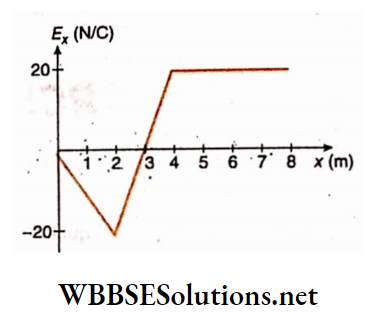
1. Electric potential at x = 2 m is
- 10V
- 20V
- 30V
- 40V
Answer: 3. 30V
2. The greatest positive value of electric potential for any point in the region 0 ≤ x ≤ 6 m on the x-axis is
- 10V
- 20V
- 30V
- 40V
Answer: 4. 40V
3. The value of x for which potential is zero is
- 2m
- 3m
- 4m
- 5.5 m
Answer: 4. 5.5 m
Question 44. 64 tiny drops of water having the same radius and same charge are combined to form one large drop. The ratio of the potential of the large drop to the small drop is
- 4:1
- 1:4
- 16:1
- 1:16
Answer: 3. 16:1
Potential of one tiny drop, \(V_1=\frac{1}{4 \pi \epsilon_0} \frac{q}{r}\)
Now, a charge of the large water drop = 64q
The ratio of the volume of the tiny water drop to the volume of the large water drop = 1: 64
Then, ratio of their radii = \(1: \sqrt[3]{64}\)
= 1: 4
∴ The potential of the large water drop
⇒ \(V_2=\frac{1}{4 \pi \epsilon_0} \frac{64 q}{4 r}=16 V_1\)
i.e., \(\frac{V_2}{V_1}=\frac{16}{1}\)
= 16: 1
The option 3 is correct
Question 45. An infinite sheet carrying a uniform surface charge density σ lies on the xy-plane. The work done to carry a charge q from point \(\vec{A}=a(\hat{i}+2 \hat{j}+3 \hat{k})\) to the point \(\vec{B}=a(\hat{i}-2 \hat{j}+6 \hat{k})\)(where a is a constant with the dimension of length and ∈0 is the permittivity of free space) is
- \(\frac{3 \sigma a q}{2 \epsilon_0}\)
- \(\frac{2 \sigma a q}{\epsilon_0}\)
- \(\frac{5 \sigma a q}{2 \epsilon_0}\)
- \(\frac{3 \sigma a q}{\epsilon_0}\)
Answer: 1. \(\frac{3 \sigma a q}{2 \epsilon_0}\)
Distance between the points, \(\vec{r}=\vec{B}-\vec{A}=a(-4 \hat{j}+3 \hat{k})\)
Field intensity at a point due to an infinite sheet carrying a uniform surface charge density cr lies on the xy-plane,
⇒ \(\vec{E}=\frac{\sigma}{2 \epsilon_0} \hat{k}\)
∴ Electric force acting on the charge q, \(q, \vec{F}=q \vec{E}=\frac{q \sigma}{2 \epsilon_0} \hat{k}\)
∴ Work done, \(W=\vec{F} \cdot \vec{r}=\frac{q \sigma}{2 \epsilon_0} \hat{k} \cdot a(-4 \hat{j}+3 \hat{k})\)
= \(\frac{3 q \sigma a}{2 \epsilon_0}\)
The option 1 is correct
Question 46. The angle between an equipotential surface and electric lines of force is
- 0°
- 90°
- 180°
- 270°
Answer: 2. 90°
The option 2 is correct.
Question 47. A point charge -q is carried from point A to point B on the axis of a charged ring of radius r carrying a charge +q. If point A is at a distance|r from the centre of the ring and point B is|r from the centre but on the opposite side, what is the network that needs to be done for this?
- \(-\frac{7}{5} \frac{q^2}{4 \pi \epsilon_0 r}\)
- \(-\frac{1}{5} \frac{q^2}{4 \pi \epsilon_0 r}\)
- \(\frac{7}{5} \frac{q^2}{4 \pi \epsilon_0 r}\)
- \(\frac{1}{5} \frac{q^2}{4 \pi \epsilon_0 r}\)
Answer: 2. \(-\frac{1}{5} \frac{q^2}{4 \pi \epsilon_0 r}\)
Net work done (W) = electric potential energy at point B – electric potential energy at point A
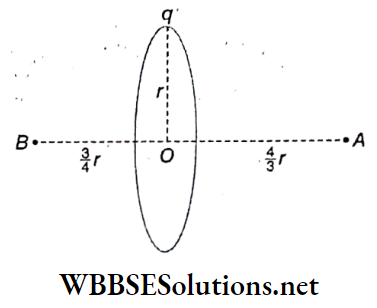
or, \(W=\frac{1}{4 \pi \epsilon_0} \cdot \frac{(+q)(-q)}{\sqrt{r^2+\left(\frac{3}{4} r\right)^2}}-\frac{1}{4 \pi \epsilon_0} \cdot \frac{(+q)(-q)}{\sqrt{r^2+\left(\frac{4}{3} r\right)^2}}\)
⇒ \(-\frac{1}{5} \cdot \frac{q^2}{4 \pi \epsilon_0 r}\)
The option 2 is correct.
Question 48. Two positive charges Q and 4Q are placed at points A and B respectively, where B is at a distance of d units to the right of A. The total electric potential due to these charges is minimum at P on the line through A and B. What is (are) the distance(s) of P from A?
- \(\frac{d}{3}\) units to the right of A
- \(\frac{d}{3}\) units to the left of A
- \(\frac{d}{5}\) units to the right of A
- d units to the left of A
Answer: 1. \(\frac{d}{3}\) units to the right of A
Let a unit positive charge be placed at point P between points A and B and at a distance x from A
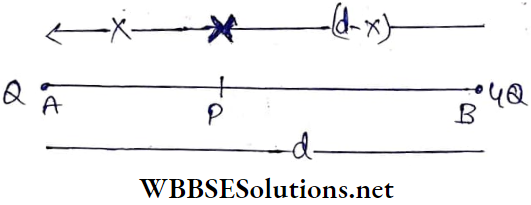
Total potential at point P due to charges Q and 4Q,
⇒ \(V=\frac{Q}{x}+\frac{4 Q}{(d-x)}\)
For the potential to be minimum at point P
⇒ \(\frac{d V}{d x}=0 \quad\)
or, \(\frac{d}{d x}\left[\frac{Q}{x}+\frac{4 Q}{d-x}\right]=0 \quad\)
or, \(x=\frac{d}{3}\)
∴ The electric potential is minimum at a distance \(\frac{d}{3}\) from point A on its right.
The option 1 is correct.
Question 49. Assume that an electric field \(\vec{E}=30 x^2 \hat{i}\) exists in space. Then the potential difference VA– VO, where VO is the potential at the origin and VA the potential at x – 2 m is
- 80 J
- 120 J
- -120 J
- -80 J
Answer: 4. -80 J
We know, \(\vec{E}=-\frac{d V}{d x} \hat{i} \quad\)
or, \(\int_{V_O}^{V_A} d V=-\int_0^2 30 x^2 d x\)
∴ \(V_A-V_O=-30\left[\frac{x^3}{3}\right]_0^2\)
= -80 J
The option 4 is correct.
Question 50. A uniformly charged solid sphere of radius R has potential VO (measured with respect to ∞ ) on its surface. For this sphere the equipotential surfaces with potentials \(\frac{3 V_0}{2}\), \(\frac{5 V_0}{4}, \frac{3 V_0}{4} \text { and } \frac{V_0}{4}\) have radius R1, R2, R3 and R4 respectively. Then
- R1= 0 and R2 > (R4– R3)
- R1 ≠ 0 and (R2-R1)>(R4-R3)
- R1 = 0 and R2 < (R4– R3)
- 2R < R4
Answer: 3. R1 = 0 and R2 < (R4– R3)
⇒ \(V_0=\frac{1}{4 \pi \epsilon_0} \frac{q}{R}\) [q = charge of tire sphere]
Now, \(\frac{3 V_0}{4}, \frac{V_0}{4}<V_0\)
So, these equipotential surfaces will be situated outside the sphere
⇒ \(R_3, R_4>R\)
In that case,
⇒ \(\frac{3 V_0}{4}=\frac{1}{4 \pi \epsilon_0} \frac{q}{R_3} \quad\)
or, \(\frac{3}{4} \frac{1}{4 \pi \epsilon_0} \frac{q}{R}=\frac{1}{4 \pi \epsilon_0} \frac{q}{R_3}\)
i,e., \(R_3=\frac{4}{3} R\)
Againg \(\frac{V_0}{4}=\frac{1}{4} \frac{1}{4 \pi \epsilon_0} \frac{q}{R}\)
= \(\frac{1}{4 \pi \epsilon_0} \frac{q}{R_4} \quad\)
i.e., \(R_4=4 R\)
∴ \(R_4-R_3=\frac{8}{3} R\)
On the other hand, \(\frac{3 V_0}{2}, \frac{5 V_0}{4}>V_0\); these equipotential surfaces are situated inside the sphere R1, R2<R. Potential at any point inside the sphere at a distance r(r<R) from the center of the sphere,
⇒ \(V=\frac{1}{4 \pi \epsilon_0} \frac{q}{2 R^3}\left(3 R^2-r^2\right)\)
= \(\frac{V_0}{2 R^2}\left(3 R^2-r^2\right)\)
∴ In the first case,
⇒ \(\frac{3}{2} V_0=\frac{V_0}{2 R^2}\left(3 R^2-R_1^2\right) \quad \text { or, } R_1=0\)
In the second case,
⇒ \(\frac{5}{4} V_0=\frac{V_0}{2 R^2}\left(3 R^2-R_2^2\right) \quad \text { or, } R_2=\frac{1}{\sqrt{2}} R\)
The option 3 is correct.
Question 51. Three concentric metal shells A, B and C of respective radii a, b and c (a<b<c) have surface charge densities +σ, -σ and +σ respectively. The potential of shell B is
- \(\frac{\sigma}{\epsilon_0}\left[\frac{b^2-c^2}{b}+a\right]\)
- \(\frac{\sigma}{\epsilon_0}\left[\frac{b^2-c^2}{c}+a\right]\)
- \(\frac{\sigma}{\epsilon_0}\left[\frac{a^2-b^2}{a}+c\right]\)
- \(\frac{\sigma}{\epsilon_0}\left[\frac{a^2-b^2}{b}+c\right]\)
Answer: 4. \(\frac{\sigma}{\epsilon_0}\left[\frac{a^2-b^2}{b}+c\right]\)
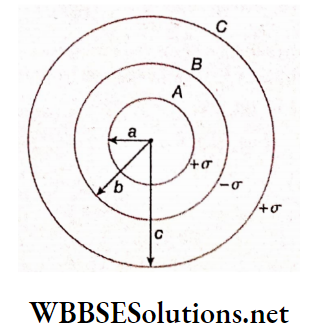
The potential of shell B,
⇒ \(V_B=\frac{1}{4 \pi \epsilon_0}\left[\frac{(+\sigma) 4 \pi a^2}{b}+\frac{(-\sigma) 4 \pi b^2}{b}+\frac{(+\sigma) 4 \pi c^2}{c}\right]\)
⇒ \(\frac{\sigma}{\epsilon_0}\left[\frac{a^2-b^2}{b}+c\right]\)
The option 4 is correct.
Question 52. A conducting sphere of radius R is given a charge Q . The electric potential and the electric field at the centre of the sphere respectively are
- \(\text { zero and } \frac{Q}{4 \pi \epsilon_0 R^2}\)
- \(\frac{Q}{4 \pi \epsilon_0 R} \text { and zero }\)
- \(\frac{Q}{4 \pi \epsilon_0 R} \text { and } \frac{Q}{4 \pi \epsilon_0 R^2}\)
- Both are Zreo
Answer: 2. \(\frac{Q}{4 \pi \epsilon_0 R} \text { and zero }\)
Question 53. In a region, the potential is represented by V(x, y, z) = 6x-8xy-8y+6yz where V is in volts and x, y, z are in metres. The electric force experienced by a charge of 2 coulomb situated at point (1, 1, 1) is
- 6√5N
- 30 N
- 24 N
- 4√35N
Answer: 4. 4√35N
We know,
⇒ \(\vec{E}=E_x \hat{i}+E_y \hat{j}+E_z \hat{k}\)
= \(-\frac{d V}{d x} \hat{i}-\frac{d V}{d y} \hat{j}-\frac{d V}{d z} \hat{k}\)
Now, V(x, y,z) = 6x – 8xy – 8y + 6yz
∴ \(\frac{d V}{d x}=6-8 y ; \frac{d V}{d y}=-8 x-8+6 z ; \frac{d V}{d y}=6 y\)
∴ \(\vec{E}=-(6-8 y) \hat{i}-(-8 x-8+6 z) \hat{j}-6 y \hat{k}\)
∴ Electric field at point (1, 1, 1),
⇒ \(\vec{E}=-(6-8 \times 1) \hat{i}-(-8 \times 1-8+6 \times 1) \hat{j}-(6 \times 1) \hat{k}\)
⇒ \(2 \hat{i}+10 \hat{j}-6 \hat{k}\)
⇒ \(E=\sqrt{2^2+10^2+(-6)^2}=\sqrt{140}=2 \sqrt{35}\)
∴ Force acting on charge 2 C,
F = qE
= 2 x 2√35
= 4√35 N
The option 4 is correct
Question 54. A molecule of a substance has permanent dipole moment p. A mole of this substance is polarised by applying a strong electrostatic field E. The direction of the field is suddenly changed by an angle of 60°. If (V is Avogadro’s number the amount of work done by the field is
- 2NpE
- \(\frac{1}{2}\)
- NpE
- \(\frac{3}{2}\)
Answer: 2. \(\frac{1}{2}\)
The potential energy of electric dipole (\(\vec{p}\)) in an electric field \((\vec{E})=-\vec{p} \cdot \vec{E}=-p E \cos \theta\)
So, the work done by the field on N molecules
= change in potential energy
= -NpE( cos60°- cosθ°) = \(\frac{1}{2}\) NpE
The option 2 is correct.

